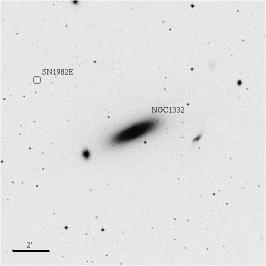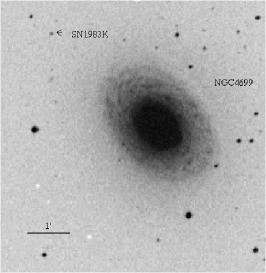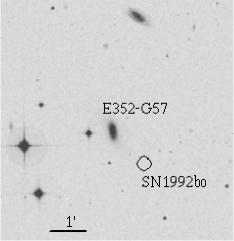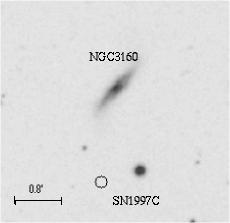| SN 1982E | SN 1983K |
|---|---|
 |
 |
| SN 1992BO | SN 1997C |
 |
 |
Latest results (based on SAI SN catalogue) are here
During my visit to ITP UCSB in august 20 - September 1997 I have studied radial distribution of SNe in parent galaxies. The purpose of this research was to revise the conclusions of previous work on the base of more complete sample of SNe and another method for correction for inclination of disk of hosted galaxy which is one of the main source of biases.
While the main conclusions of previous paper "Distribution of supernovae relative to spiral arms and HII regions" (with D.Yu.Tsvetkov and I.V.Filimonova) PASP, 106, 1276,1994 were confirmed, some new results were also obtained.
One explanation for lack of supernovae of type Ia in central regions of spiral galaxies could be large velocity of binary systems (~500 km/sec) and short "lifetime" of such systems in central part of galaxy.
Henry C. Ferguson, Nial R.Tanvir, Ted von Hippel have found about 600 red giant stars in intergalactic space. (The paper entitled "Detection of Intergalactic Red Giant Branch Stars in the Virgo Clusters" appeared in SISSA (23 Jan 1998). This fact could explain appearance of old supernovae such as SN Ia far outside of galaxies ("outlier" supernovae) and cannot be implemented for young massive SNe of types II and Ib because they require red supergiants which were not observed while being intrinsically brighter than red giants discovered.
There are no evident explanations of these results and one could speculate about their reliability (there are many questionable moments) but in my opinion they provide a good challenge to continue of studying of radial distribution of SNe and could direct us to progenitors of SNe.
| SN 1982E | SN 1983K |
|---|---|
 |
 |
| SN 1992BO | SN 1997C |
 |
 |
The table presents the list of 'outlying' SNe (with relative radial distance from the center of galaxy r >1.5) and their main parameters. The distances D to parent galaxies were estimated using H = 75km/sMpc, the radius of galaxy R (in arcseconds and in kpc) was computed using the diameter D25 as in RC3 and the adopted distance. a/b is the ratio of major to minor axes of the galaxy. The relative distance r for SNe was computed as the ratio of SN offset to the radius of the galaxy measured along the radius-vector of SN, that is we assume that SN lies near the plane of the galaxy. This may be not true for the 'outlying' SNe, but most of SNe in this list would still have r > 1.5 if we compute r using the major radius of the galaxy; on the other hand, as we observe only the projection of the real distance on the sky, in many cases our data is the lower limit to the real value of r and R. So this procedure for obtaining r and R can partly compensate this effect.
| SN | GALAXY | SUPERNOVA | ||||||||||||
|---|---|---|---|---|---|---|---|---|---|---|---|---|---|---|
| ID | Id | Type | Mag | Vr | D,Mpc | R," | a/b | R,kpc | Offset | Mag | r | R,kpc | Type | |
| 1955F | M 00-31-25 | .SXR1. | 15.0 | 5971 | 78 | 34 | 3.1 | 13 | 15E | 17N | <19.5 | 1.9 | 25 | |
| 1960G | M 03-29-60 | .S..5. | 16.0 | 16 | 1.6 | 14E | 6S | <17.5 | 1.7 | |||||
| 1961D | M 05-30-101 | .E.0.. | 14.8 | 7455 | 99 | 9 | 1.4 | 4 | 32E | 12S | 16.2 | 3.6 | 16 | I |
| 1961G | M 04-25-12 | .S..3. | 16.3 | 16125 | 213 | 4 | 1.4 | 4 | 9W | 2S | <18.2 | 2.8 | 11 | |
| 1961S | M 04-25-05 | .E.... | 15.8 | 5 | 1.0 | 19E | 6S | <18.3 | 4.4 | |||||
| 1962O | M 07-08-01 | .E.... | 18.6 | 14150 | 190 | 9 | 1.0 | 8 | 15E | 11N | <19.8 | 2.1 | 17 | |
| 1963F | M 05-36-18 | .E.2.. | 17.7 | 22175 | 297 | 3 | 1.0 | 4 | 1W | 7S | <17.6 | 2.2 | 10 | |
| 1966O | INTERGAL | <15.5 | ||||||||||||
| 1967E | M 07-06-18 | .S..1. | 17.0 | 26544 | 356 | 11 | 1.2 | 19 | 18W | 16N | <18.0 | 1.7 | 32 | |
| 1968Z | N 7768 | .E.... | 14.0 | 8191 | 112 | 47 | 1.2 | 25 | 24W | 61N | <17.9 | 1.7 | 44 | |
| 1968aa | N 4975 | .LXT0P | 15.5 | 5302 | 69 | 31 | 1.6 | 10 | 12E | 36N | <15.0 | 1.6 | 16 | |
| 1969L | N 1058 | .SAT5. | 11.8 | 518 | 9 | 90 | 1.1 | 4 | 190E | 110S | 13.1 | 2.6 | 10 | IIP |
| 1970L | N 2968 | .I.0.. | 13.1 | 1450 | 26 | 69 | 1.4 | 9 | 120E | 75N | <13.3 | 2.1 | 19 | |
| 1971C | N 3904 | .E.2.. | 11.9 | 1546 | 23 | 81 | 1.4 | 9 | 167W | 60S | <15.3 | 2.8 | 25 | |
| 1973A | N 3574 | .S.... | 15.7 | 13 | 1.0 | 2W | 30N | <18.0 | 2.3 | |||||
| 1980M | E 366-G05 | .S..5. | 14.8 | 32 | 1.4 | 23W | 46S | <17.0 | 1.9 | |||||
| 1980I | N 4374? | .E.1.. | 10.8 | 951 | 16 | 194 | 1.1 | 15 | 472E | 23N | 12.5 | 2.4 | 37 | Ia |
| 1982E | N 1332 | .L.S-. | 11.6 | 1526 | 18 | 140 | 3.2 | 12 | 318E | 171N | <14.0 | 8.2 | 98 | |
| 1982X | U 4778 | .S..3. | 14.2 | 11293 | 151 | 24 | 1.0 | 18 | 92W | 23N | <16.5 | 3.9 | 69 | |
| 1983K | N 4699 | .SXT3. | 10.5 | 1427 | 17 | 114 | 1.4 | 9 | 148E | 131N | 12.4 | 1.7 | 16 | IIP |
| 1986C | U 6697 | .I..9. | 14.3 | 6728 | 89 | 56 | 5.7 | 24 | 60W | 60N | <18.0 | 1.5 | 36 | II |
| 1991at | U 733 | .SBS3. | 15.6 | 12307 | 166 | 20 | 1.2 | 16 | 20E | 34N | <18.0 | 1.9 | 31 | Ia |
| 1992bo | E 352-G57 | .LBS0P | 14.6 | 6000 | 79 | 42 | 3.9 | 16 | 48W | 55S | 15.8 | 2.0 | 32 | Ia |
| 1993af | N 1808 | RSXS1. | 10.7 | 1007 | 11 | 194 | 1.6 | 10 | 220E | 94N | <17.0 | 1.8 | 18 | Ia |
| 1997C | N 3160 | .S.... | 15.2 | 42 | 5.6 | 18E | 96S | <17.3 | 2.3 | Ib | ||||
The main conclusions from these data are that SNe of all types can be found far beyond the optical radius of the galaxies, and the galaxies also belong to different Hubble types, although the absence of late spirals and high percent of E and S0 can be noted. The galaxies in our sample have different sizes, but the smallest have radii about 4 kpc and cannot be considered as dwarfs; the largest are giant galaxies with radius up to 25--30 kpc. Unfortunately only 1/3 of SNe in this list are classified. Among SNe Ia good light curve were observed only for SN1992bo, which appeared to be a typical Ia event, but with rate of brightness decline faster than average. SN 1969L is classical prototype of SNe IIP, while spectrum of SN 1983K showed some peculiarity due to the presence of presupernova wind. The largest relative and absolute distance in our list - 8.2 and 98 kpc for SN1982E - are largely affected by the correction, supposing SN lies in the plane of the galaxy: if we reject this, the values should be only 2.6 and 31 kpc. Nevertheless, values of r near 4-5 and R about 50-60kpc are undoubtedly real, and as we mentioned above, this may be only the upper limit for real distances.
There are also 2 "intergalactic" SNe in our list: SN 1966O, and 1980I, for which no parent galaxies were reported at discovery. SN 1980I is type Ia SN which appeared in the Virgo cluster of galaxies between giant ellipticals NGC4374 and NGC4406, in our table we assume it is more likely associated with NGC4374. Very few data exist for SNe 1966O, and we should stress the need for investigation of these and similar events.
I would like to thank ITP UCSB and Organizing Committee of Supernovae research program for invitation and hospitality and for chance to communicate with supernova community.
This research was supported in part by the NSF grant PHY94-07194.
Last updated: February 1998